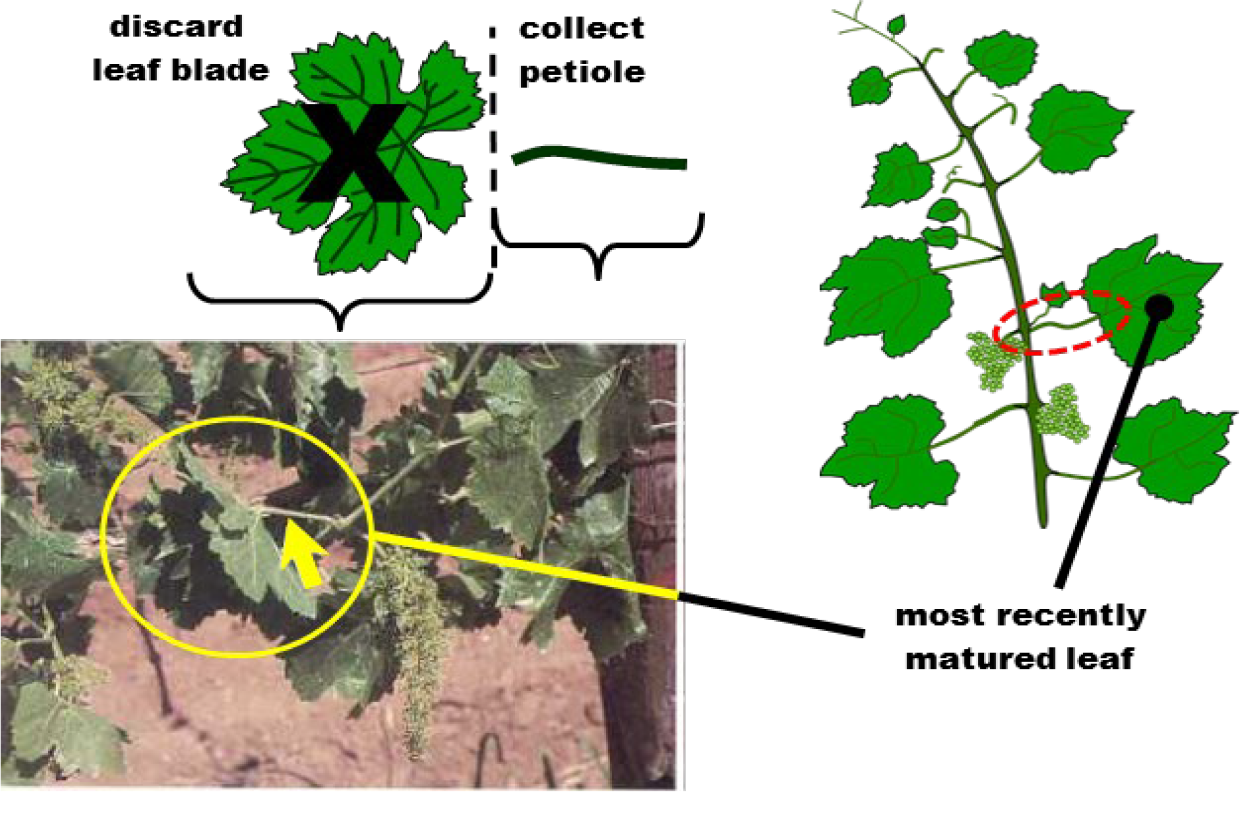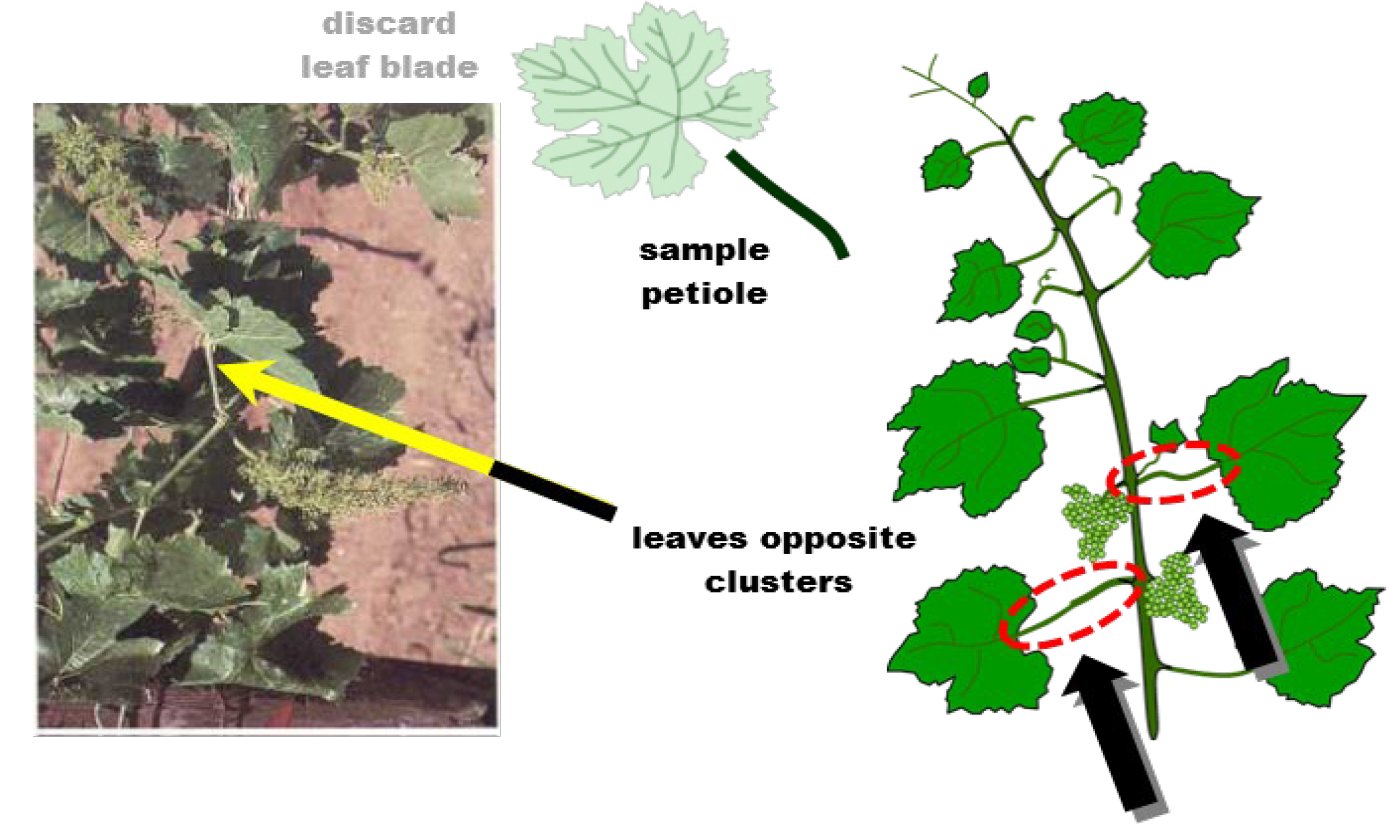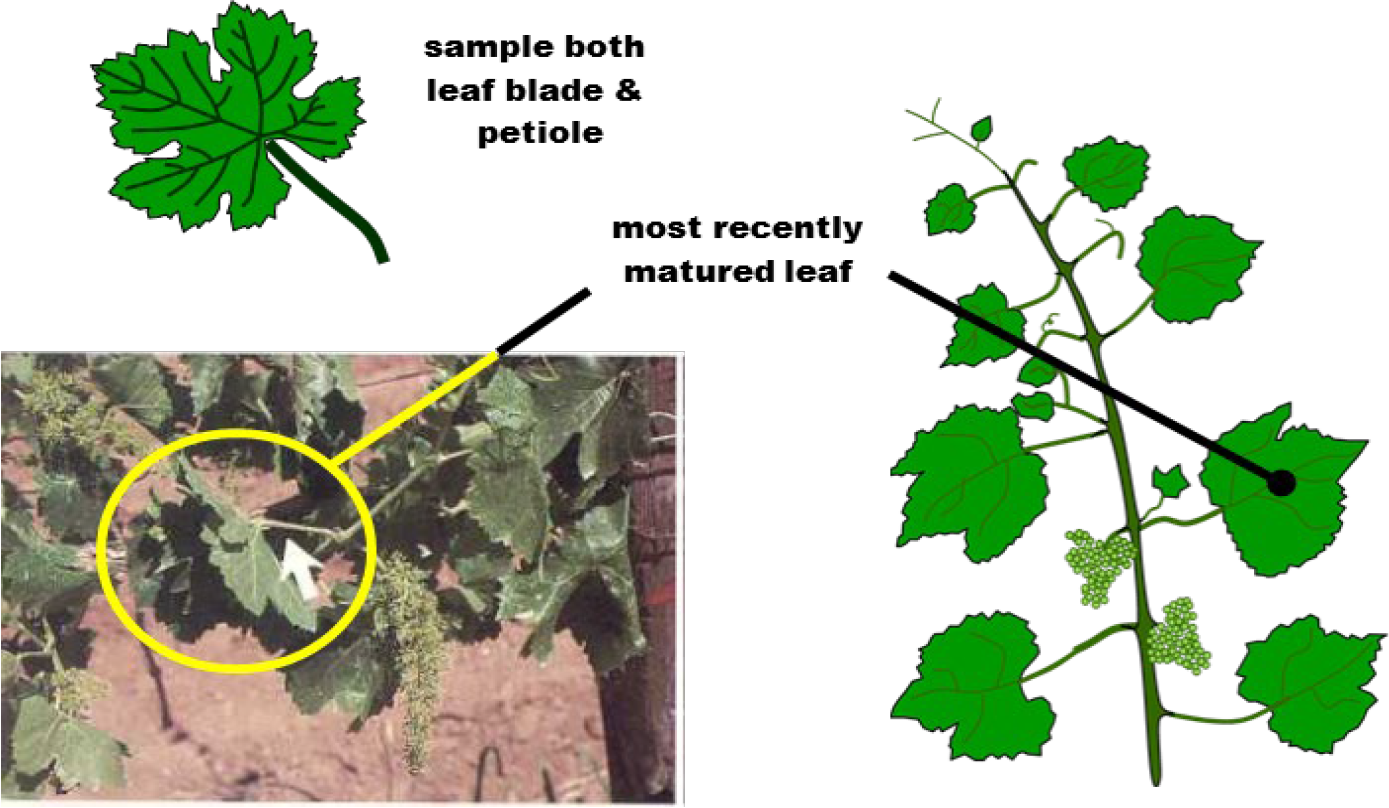⇦ Back to Soil Fertility and Plant Nutrition Home
¶ Grapes (Vitus vinifera)
| Table No: | Growth stage: | Plant part: |
| Table A | Full bloom | Petiole |
| Table B | Early ripening (veraison) | Petiole |
| Table C | Full bloom | Mature leaves and petiole |
| Table D | Early ripening (veraison) | Mature leaves and petiole |
¶ A: Full bloom
Plant Part: Petioles from most recently developed, matured leaf
Sampling Procedure: "Full bloom" considered to be when about two-thirds of the flower caps have been shed. Collect a representative sample from 25 to 40 vines of the same variety. Collect petioles from two mature, fully expanded leaves on each vine, usually the fifth to seventh leaves from the shoot tip. Avoid young or senescent leaves. Detach each petiole from the leaf blade immediately.
| Analysis | Tissue Concentration Guidelines | ||||||||
| Low/Marginal Range | Sufficiency Range | Excessive, toxic? | |||||||
| Nitrogen, % N | 2.1 | - | 2.5 | 2.5 | - | 3.8 | |||
| Phosphorus, %P | 0.2 | - | 0.3 | 0.3 | - | 0.6 | |||
| Potassium, % K | 0.9 | - | 1.5 | 1.5 | - | 2.5 | |||
| Calcium, % Ca | 0.8 | - | 1.2 | 1.2 | - | 1.8 | |||
| Magnesium, % Mg | 0.1 | - | 0.2 | 0.2 | - | 0.5 | |||
| Sulfur, % S | 0.2 | - | 0.2 | 0.2 | - | 0.4 | |||
| Zinc, ppm Zn | 20 | - | 30 | 30 | - | 100 | |||
| Iron, ppm Fe | 20 | - | 40 | 40 | - | 180 | |||
| Manganese, ppm Mn | 20 | - | 30 | 30 | - | 150 | |||
| Copper ppm Cu | 3 | - | 5 | 5 | - | 15 | |||
| Boron, ppm B | 20 | - | 25 | 25 | - | 50 | |||
| Nitrogen-to-sulfur ratio (N:S) | 15 | - | 20 | 10 | - | 15 | |||
| Sodium, % Na | > 0.35 | ||||||||
| Chloride, % Cl | > 0.30 | ||||||||
| Nitrate, ppm NO3-N | |||||||||
| Phosphate, ppm PO4-P | |||||||||
¶ Figure A.

¶ B: Early ripening (veraison)
Plant Part: Petioles from matured leaves
Sampling Procedure: "Veraison" refers to growth stage of berry softening at beginning of ripening. Collect a representative sample from 25 to 40 vines of the same variety. Collect petioles from two leaves that are opposite of clusters of bunches, toward the base of the shoots. Detach each petiole from the leaf blade immediately. Avoid young or senescent leaves.
| Analysis | Tissue Concentration Guidelines | ||||||||
| Low/Marginal Range | Sufficiency Range | Excessive, toxic? | |||||||
| Nitrogen, % N | 1.35 | - | 1.70 | 1.70 | - | 3.00 | |||
| Phosphorus, %P | 0.12 | - | 0.15 | 0.15 | - | 0.50 | |||
| Potassium, % K | 0.80 | - | 1.50 | 1.50 | - | 2.50 | |||
| Calcium, % Ca | 0.70 | - | 1.00 | 1.00 | - | 3.00 | |||
| Magnesium, % Mg | 0.15 | - | 0.30 | 0.30 | - | 1.50 | |||
| Sulfur, % S | 0.12 | - | 0.15 | 0.15 | - | 0.40 | |||
| Zinc, ppm Zn | 15 | - | 25 | 25 | - | 100 | |||
| Iron, ppm Fe | 25 | - | 40 | 40 | - | 300 | |||
| Manganese, ppm Mn | 20 | - | 30 | 30 | - | 150 | |||
| Copper ppm Cu | 3 | - | 5 | 5 | - | 50 | |||
| Boron, ppm B | 20 | - | 30 | 30 | - | 100 | |||
| Nitrogen-to-sulfur ratio (N:S) | 15 | - | 20 | 10 | - | 15 | 250 | ||
| Sodium, % Na | > 0.35 | - | 0.60 | ||||||
| Chloride, % Cl | > 0.30 | ||||||||
| Nitrate, ppm NO3-N | |||||||||
| Phosphate, ppm PO4-P | |||||||||
¶ Figure B.

¶ C: Full bloom
Plant Part: Most recently developed, matured leaves plus petioles
Sampling Procedure: "Full bloom" considered to be when about two-thirds of the flower caps have been shed. Collect a representative sample from 15 to 25 vines of the same variety. Collect a mature, fully expanded leaf from each vine usually the fifth to seventh leaves from the shoot tip. Avoid young or senescent leaves. Submit at least a pint of loosely packed tissue (a ball about 4 to 5 inches in diameter).
| Analysis | Tissue Concentration Guidelines | ||||||||
| Low/Marginal Range | Sufficiency Range | Excessive, toxic? | |||||||
| Nitrogen, % N | 2.10 | - | 2.70 | 2.70 | - | 4.00 | |||
| Phosphorus, %P | 0.15 | - | 0.25 | 0.25 | - | 0.40 | |||
| Potassium, % K | 0.90 | - | 1.20 | 1.20 | - | 1.80 | |||
| Calcium, % Ca | 0.70 | - | 1.10 | 1.10 | - | 2.50 | |||
| Magnesium, % Mg | 0.15 | - | 0.20 | 0.20 | - | 0.50 | |||
| Sulfur, % S | 0.14 | - | 0.18 | 0.18 | - | 0.35 | |||
| Zinc, ppm Zn | 18 | - | 30 | 30 | - | 80 | |||
| Iron, ppm Fe | 40 | - | 60 | 60 | - | 200 | |||
| Manganese, ppm Mn | 30 | - | 60 | 60 | - | 300 | |||
| Copper ppm Cu | 3 | - | 5 | 5 | - | 40 | |||
| Boron, ppm B | 15 | - | 25 | 25 | - | 70 | |||
| Nitrogen-to-sulfur ratio (N:S) | 15 | - | 20 | 10 | - | 15 | |||
| Sodium, % Na | > 0.35 | - | 0.60 | ||||||
| Chloride, % Cl | > 0.30 | ||||||||
| Nitrate, ppm NO3-N | |||||||||
| Phosphate, ppm PO4-P | |||||||||
¶ Figure C.

¶ D: Early ripening (veraison)
Plant Part: Matured leaves plus petioles
Sampling Procedure: "Veraison" refers to growth stage of berry softening at beginning of ripening. Collect a representative sample from 15 to 25 vines of the same variety. Collect leaves that are opposite of clusters of bunches, toward the base of the shoots. Avoid young or senescent leaves. Submit at least a pint of loosely packed tissue (a ball about 4 to 5 inches in diameter).
| Analysis | Tissue Concentration Guidelines | ||||||||
| Low/Marginal Range | Sufficiency Range | Excessive, toxic? | |||||||
| Nitrogen, % N | 1.80 | - | 2.10 | 2.10 | - | 3.30 | |||
| Phosphorus, %P | 0.12 | - | 0.20 | 0.20 | - | 0.35 | |||
| Potassium, % K | 0.80 | - | 1.10 | 1.10 | - | 1.50 | |||
| Calcium, % Ca | 0.70 | - | 1.10 | 1.10 | - | 2.20 | |||
| Magnesium, % Mg | 0.15 | - | 0.20 | 0.20 | - | 0.50 | |||
| Sulfur, % S | 0.15 | - | 0.18 | 0.18 | - | 0.30 | |||
| Zinc, ppm Zn | 18 | - | 30 | 30 | - | 80 | |||
| Iron, ppm Fe | 40 | - | 60 | 60 | - | 200 | |||
| Manganese, ppm Mn | 30 | - | 60 | 60 | - | 300 | |||
| Copper ppm Cu | 3 | - | 5 | 5 | - | 40 | |||
| Boron, ppm B | 15 | - | 20 | 20 | - | 70 | |||
| Nitrogen-to-sulfur ratio (N:S) | 15 | - | 20 | 10 | - | 15 | |||
| Sodium, % Na | > 0.35 | - | 0.60 | ||||||
| Chloride, % Cl | > 0.30 | ||||||||
| Nitrate, ppm NO3-N | |||||||||
| Phosphate, ppm PO4-P | |||||||||
¶ Figure D.

Vitus vinifera includes many varieties grown for use in wine making, as table grapes, and for raisins.
These interpretations are developed from data collected across a wide range of conditions. Plant tissue levels can vary between varieties or be affected by any stress affecting nutrient uptake, Uniformly weak vine growth may be a symptom of low nitrogen or water stress, disease and overcropping.
Overall vine vigor and leaf appearance are the best indicators of nitrogen status. Weak growth, poor leaf color and fruit set, and early defoliation indicate low levels of one or more nutrients. Delayed vine and fruit maturity and excessive vigor suggest an over-application or late application of nitrogen.
Highly vigorous vines may not not need nitrogen, regardless of tissue levels.